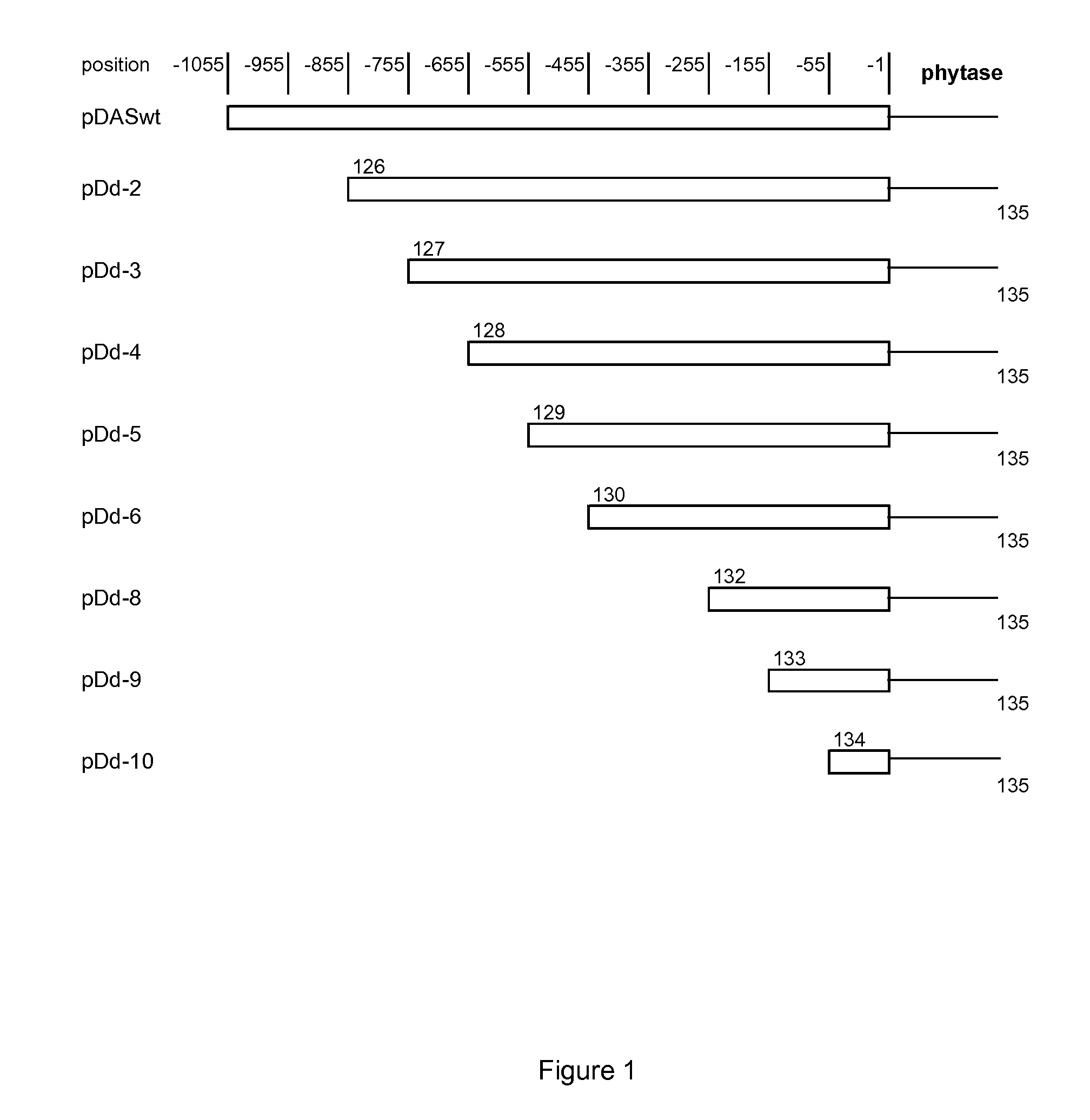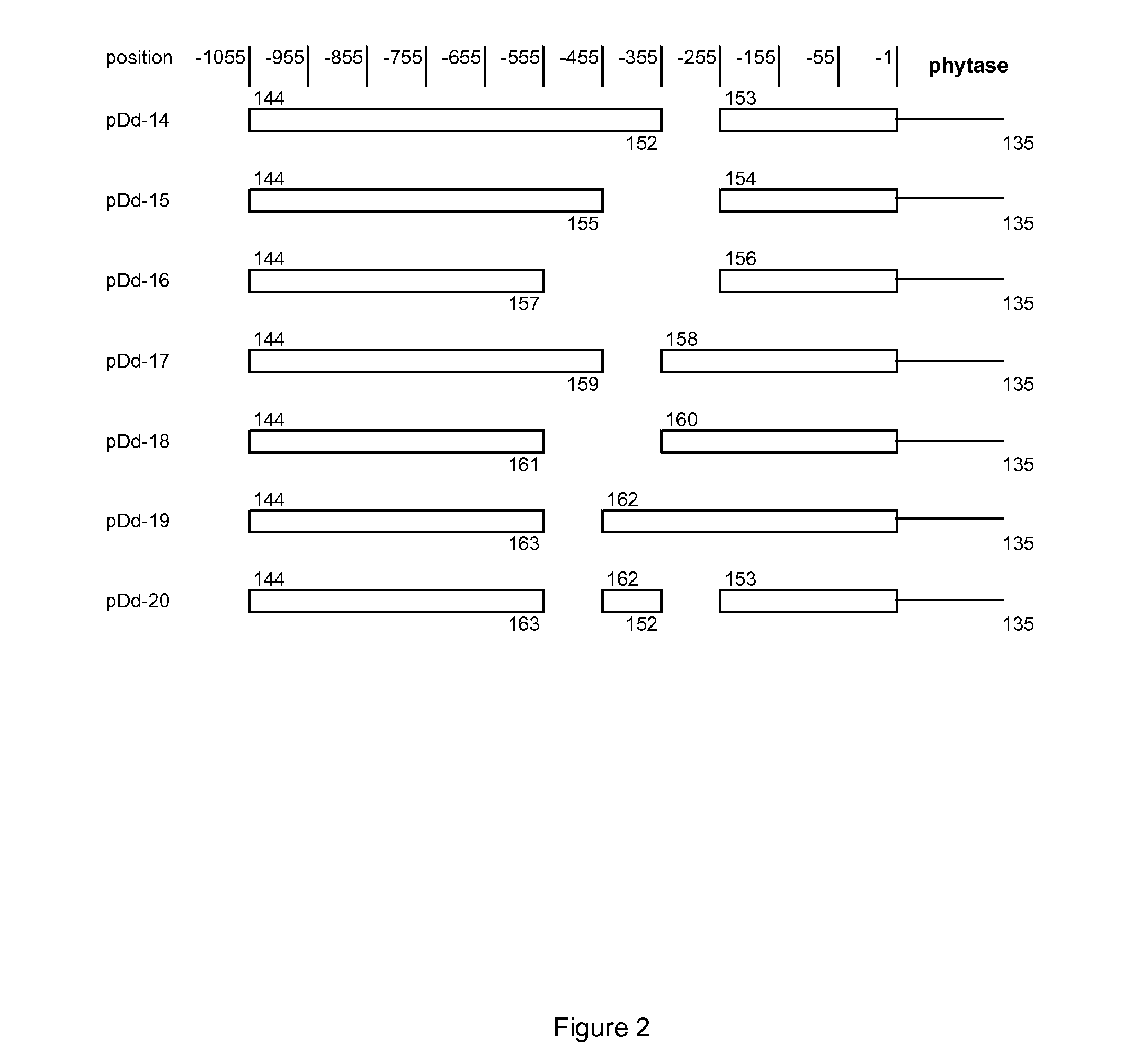Pichia Pastoris Das Promoter Variants
- Summary
- Abstract
- Description
- Claims
- Application Information
AI Technical Summary
Benefits of technology
Problems solved by technology
Method used
Image
Examples
example 1
Construction and Expression Evaluation DAS1 Promoter Variants
[0120]Cloning of DAS promoter of Pichia pastoris has been described previously (WO 2008 / 090211). An expression cassette consisting of the wt DAS promoter from Pichia pastoris controlling the expression of a phytase gene, optimized for expression in Pichia, was used for the construction of promoter variants (deletion variants). The complete sequence of the promoter fragment is shown in SEQ ID NO: 1, the reporter gene in SEQ ID NO: 4 and the fusion construct (expression cassette) is shown in SEQ ID NO: 5 (DAS wt promoter and 5′-end of the phytase coding sequence including a codon optimized alpha factor signal peptide encoding sequence). Promoter variants of different length (as shown in FIG. 1 in which position −1 corresponds to position 1055 in SEQ ID NO: 1 and position −1055 corresponds to position 1 in SEQ ID NO: 1) were prepared by PCR using the primers shown in Table 1 and the primer combination sets shown in Table 2. T...
example 2
Construction and Expression Evaluation DAS1 Promoter Variants (2)
[0125]DAS promoter variants which possess internal deletions as shown in FIG. 2 were constructed by SOE PCR. The 1st PCR was carried out using the 50 microL of reaction including 2 mM dNTP, 10 microM of each primer shown in Table 2, 2.8 unit of Expand high fidelity plus (Roche), 1× Expand high fidelity plus buffer (Roche), and 2 ng of the plasmid DNA of pDAS1 wt. The PCR program is as below.
temptimecycle94° C.2min194° C.10sec1155° C.30sec68° C.3min94° C.10sec2055° C.30sec68° C.3 min + 20 sec / cycle68° C.7min1
[0126]The purified fragments from 1st PCR were subjected to the 2nd PCR using the 50 microL of reaction including 2 mM dNTP, 10 microM of primer 144 and primer135, 2.8 unit of Expand high fidelity plus (Roche), 1× Expand high fidelity plus buffer (Roche), and purified PCR product of the 1st run. The PCR program is as below.
Temptimecycle94° C.2min194° C.10sec1160° C.30sec68° C.3min94° C.10sec2060° C.30sec68° C.3 min ...
example 3
Amplification of UAS in DAS Promoter
[0129]DAS promoter variants in which the number of the UAS is amplified were constructed. The resulting constructs are illustrated in FIG. 3. The UAS was amplified by PCR and the constructs were based on the wild type DAS promoter shown as pDAS wt2 in the figure and the complete sequence from the NsiI site and including the phytase gene encoding the N-terminal is shown in SEQ ID NO: 6. The amplification resulted in constructs having multiple copies of the UAS as shown in FIG. 3 and by using the primers 201 and 202 these constructs were sub-cloned into pDAS1 wt.
[0130]The promoter region and a part of phytase gene were amplified by PCR using primer 201 and primer 202 with the 50 microL of reaction mixture including 2 mM dNTP, 10 microM of each primer, 2.8 unit of Expand high fidelity plus (Rosche), 1× Expand high fidelity plus buffer (Rosche), and 2 ng of the plasmid of template DNA. The PCR program is as below.
temptimecycle94° C.2min194° C.10sec115...
PUM
| Property | Measurement | Unit |
|---|---|---|
| Fraction | aaaaa | aaaaa |
| Fraction | aaaaa | aaaaa |
| Fraction | aaaaa | aaaaa |
Abstract
Description
Claims
Application Information
 Login to View More
Login to View More - R&D
- Intellectual Property
- Life Sciences
- Materials
- Tech Scout
- Unparalleled Data Quality
- Higher Quality Content
- 60% Fewer Hallucinations
Browse by: Latest US Patents, China's latest patents, Technical Efficacy Thesaurus, Application Domain, Technology Topic, Popular Technical Reports.
© 2025 PatSnap. All rights reserved.Legal|Privacy policy|Modern Slavery Act Transparency Statement|Sitemap|About US| Contact US: help@patsnap.com



